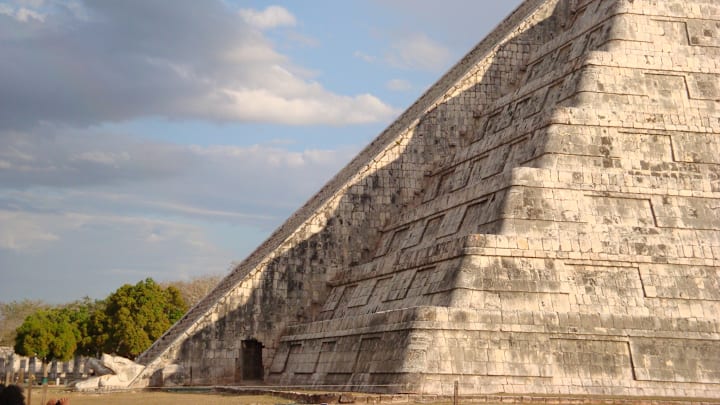On Sunday, March 20, the vernal equinox will herald the first day of spring in the Northern Hemisphere. Ancient civilizations built calendars and observatories to track the movements of the stars and mark this monumental time. Now, people still partake in a variety of traditions and rituals to honor the day when light and dark become equal. To take your celestial celebrations to the next level, here are 10 places that align with the spring equinox.
1. A massive snake appears on the temple at Chichen Itza.
Legend says that on the spring and fall equinoxes, the Maya city of Chichen Itza receives an otherworldly visitor: Kukulcan, the feathered serpent deity. On these days, a shadowy snake slithers down the side of the god's namesake pyramid. As the temple darkens, a single strip of light stretches from the top of the northern staircase to the snake head resting at the bottom, creating the illusion of a wriggling reptile.
2. A beam of light illuminates a petroglyph within Arizona’s Boulder House.
The Boulder House in Scottsdale, Arizona, looks like a strange home wedged amid a jumble of rocks. But it’s actually a modern house built around a sacred Native American site. The Empie family, who bought the parcel of desert land in the 1980s, commissioned architect Charles Johnson to transform the cluster of 1.6-billion-year-old boulders into a functional house. Johnson crafted a unique structure, incorporating the rocks into the house’s foundation and preserving the prehistoric carvings. On the equinox, sunlight pierces between two boulders in the unusual abode, striking a spiral petroglyph on the wall to create a dazzling piece of home decor.
3. A group of Moai on Rapa Nui (Easter Island) stare directly at the sunset.

People aren’t the only ones who pause to watch the sun slip beneath the horizon on the first day of spring. On Rapa Nui (Easter Island), at a sacred site called Ahu Akivi, a line of seven Moai—the island’s giant, mysterious heads—gaze directly at the point at which the sun sets in the sky on the equinox.
4. Light drenches a petroglyph-filled cairn at Loughcrew.
The hills of Loughcrew, one of Ireland’s four main passage tomb sites, are crowned by 5000-year-old megalithic structures. At dawn on the equinox, sunlight fills Cairn T, a passage tomb carved with astoundingly well-preserved examples of Neolithic art. As the light dissolves the darkness, the cup marks that dimple its walls and the symbols adorning its back stones blaze into view. The illumination lasts for about 50 minutes, giving observers ample time to take turns squeezing into the cairn.
5. Light streams through one of the Mnajdra Prehistoric Temples.
The Mnajdra Prehistoric Temples on Malta’s southern coast are archaeological wonders. They were built between 3600 and 2500 BCE and are believed to be among the world’s oldest freestanding stone buildings. Not much is known about the people who created these megalithic masterpieces, though it’s clear they constructed one of the temples with an eye to the heavens. On the equinox, the sun streams through the South Temple’s main doorway, flooding the structure’s major axis with light.
6. The sun sits directly atop the main temple at Angkor Wat.
Watching the sun rise over Angkor Wat would be a magical experience any day. Crowds hush as colorful hues paint the world’s largest religious structure with a gilded glow. Dawn at Angkor Wat is even more special on the equinoxes. Then, the sun rises behind the main temple before briefly seeming to balance on its tip like a fiery halo.
7. The sun rises through the entrance to Stonehenge Aotearoa on the Southern Hemisphere's spring equinox.
Stonehenge has inspired replicas around the globe—including as far away as New Zealand. Stonehenge Aotearoa, which opened in 2005, was built by the Phoenix Astronomical Society. The structure is an astronomical tool for observing the local skies, and blends modern astronomy with ancient starlore. If you stand in the center of the circle on the Southern Hemisphere's vernal equinox, you can watch the sun rise directly through the Sun Gate, two carved pillars that flank the entrance to the henge.
8. The shadow of the intihuatana at Machu Picchu disappears at noon.
A curious stone structure stands atop a temple at Machu Picchu. It’s one of the rare surviving intihuatanas that wasn’t demolished by the Spanish conquistadors. This “hitching post of the sun” is believed to have been an astronomical tool. At noon on the equinox, the granite pillar’s shadow briefly vanishes. Unfortunately, the invaluable object now looks a bit battered. In 2000, a crane toppled into the intihuatana during the filming of a beer commercial, smashing part of it.
9. The sun bursts through the door of a temple at Dzibilchaltún.

Though now reduced to a medley of ruins dotting the jungle, Dzibilchaltún was once the longest continually inhabited Maya administrative and ceremonial city. The star attraction here is the Temple of the Seven Dolls, a building named for the mysterious human-like figures discovered inside. At dawn on the equinox, the sun shines through the temple’s main door. It’s believed the sacred structure was aligned with the equinoxes to mark the beginning of the planting season and the end of the harvesting season.
10. The 'Woodhenge' at the Cahokia Mounds aligns with the sunrise.
During the Mississippian cultural period, Cahokia's population exceeded that of London. In addition to giant pyramids, the North American city also featured circles of wooden posts, since dubbed “Woodhenge.” The wooden markers were likely used to track the sun’s movements. One of the posts aligns with the equinoxes, as well as with the front of Monks Mound. On sunrise on the equinox, it looks as though the sun is emerging from the enigmatic earthwork.
A version of this story originally ran in 2020; it has been updated for 2022.
